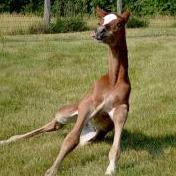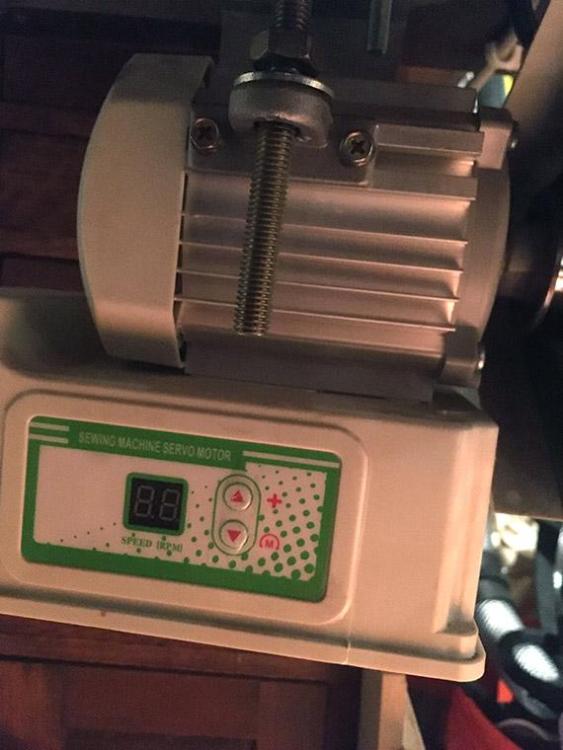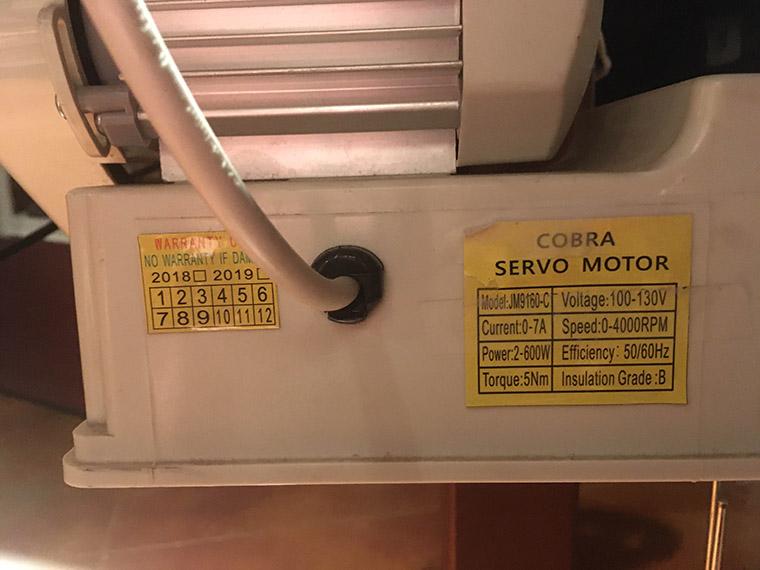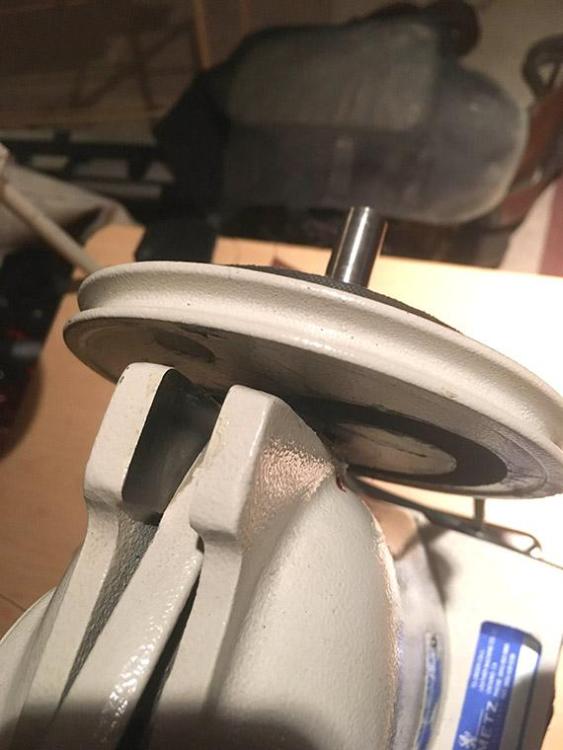-
Posts
1,287 -
Joined
-
Last visited
Content Type
Profiles
Forums
Events
Blogs
Gallery
Everything posted by TomE
-
That lead looks really nice, Jonas. I'll bet she enjoys using it. I bought a used patcher and am learning to replace zippers in riding boots. I appreciate your tips on different styles of zippers. Today I received an inquiry about patching a silver dollar-sized hole on the inside leg of a riding boot. Normally I would pass on that sort of repair but since a patcher is for patching, why not try it? Have you done any leather patches on boots or saddles?
-

Instructions for Cobra model JM9160-C servo motor?
TomE replied to TomE's topic in Leather Sewing Machines
Thanks, @1hp! Those instructions did the trick. It starts slowly/smoothly now. @CowboyBob, function S.1 is the start speed on this motor. I oiled the roller cam and the action is smoother now using the hand wheel. I will be oiling the roller religiously. Thanks for your help. @DieselTech, you were right. The top nut on the belt tensioner was loose. Probably worked loose after I set up the machine then did some sewing. That certainly could have affected the startup action. I installed the missing nut to lock the motor in place. Thanks for pointing this out. -

Instructions for Cobra model JM9160-C servo motor?
TomE replied to TomE's topic in Leather Sewing Machines
Thanks so much, @CowboyBob! I will give the instructions a try tonight. Thanks also for the advice about the needle arm lever roller/cam. Will get it cleaned up and oiled. I suspect the previous owner misplaced the nut and washer. If it's metric I probably have one. The belt tension holds the motor against the one nut I have left - that didn't come out right. -
I bought a used Cobra Class 29-18 patcher that sews well but is tricky to start up slowly. Pressing the pedal slowly, the first revolution is sometimes slow and sometimes fast before slowing to an even pace. Decreasing the maximum speed helps but doesn't solve the erratic behavior. Q: Can the startup and ramp-up speeds be adjusted on the model JM9160 motor? Does anyone have an instruction sheet for this motor? I also considered whether the problem is mechanical/friction when starting up. The machine was setting for a year or two before I bought it. I've been oiling it generously. The previous owner seemed to be good about maintenance. There is a generous amount of lithium grease on the shuttle driving gear. The slot on the needle bar cam/flywheel that actuates the needle bar driving lever is also greased. Q: Should I be greasing or oiling the slot that holds the end of the needle bar driving lever, shown in the 3rd picture? I did also check the foot pedal for smooth operation and moved the angle of the lever that pulls the linkage chain connected to the servo motor actuator arm. The actuator has a very short throw and I'm trying to maximize the foot pedal travel over the full operating range. Thanks for help and advice.
-
Was going to make a joke about Camel (Campbell) Soups…. We have a friend who operates mobile petting zoos in the Saint Louis area. She recently bought a camel from a breeder in Oklahoma. Apparently camels are in demand for parties, nativity scenes, etc. She’s a skilled horse trainer and is making good progress training “Camelot” the camel. I won’t ask her about camel leather.
-
Looks like a handy knife for tight places. Keep us posted.
-

Scavenging/Salvaging leather from old Saddles.
TomE replied to Rallekcm's topic in How Do I Do That?
This maker creates beautiful bags from English saddles. https://www.calyse-co.com/ I think the value is in the artistic reinterpretation of a saddle's features, not the leather itself. Creating a keepsake from a worn out saddle. -
I guess a flat bed is good for feeding heavy/bulky projects but I don't own one. I have several cylinder arm machines. The Cobra Class 26 (LS341 clone) is a favorite for lighter leathers and sewing webbing/fabric on horse blankets and gear. It is easy to use and can handle a variety of thicknesses and shapes.
-
Several years ago, I bought a used SK-4 with the vacuum system and have been very pleased with it. I think you have a good plan to ask for the replacement parts and a partial refund - and maybe some free accessories. I would get it set up, sharpen the knife, and check that everything is in working order before negotiating with Techsew. I swapped out some parts on my bottom feed skiver in order to skive heavier leather. I switch out the feed roller for heavy vs thin leather.
-
Congratulations! Sounds like a harrowing ordeal. Glad you prevailed, and thanks to @chisel for the engineer's manuals. Much appreciated.
-

Glue and vapor permeability
TomE replied to Eelco's topic in Dyes, Antiques, Stains, Glues, Waxes, Finishes and Conditioners.
Great information, @Eelco. Prior to retirement, I was growing protein crystals from PEG solutions and shooting x-rays at the crystals. Fun to learn about more practical chemistry. Did not know about PVB, and I'm interested in your use of PEG for flexibility. Two criteria I have for gluing are short dry time before sewing and not interfering with burnishing edges. Using Barge cement for most projects. -
Tidy looking work. Well done. I'm a fan of HO bridle.
-
Thank you for all your work on this. These forums are a wonderful resource. We appreciate you.
-
@Patrick1 also makes narrow feed dogs, plates, and presser feet for the 441 clones. https://heprecision.com/
-
I covered my work table with white HDPE (https://www.menards.com/main/building-materials/panel-products/plastic-utility-panels/1-4-x-4-x-8-hdpe-panel/whtkhdpe48x96x220/p-1561703293086-c-14048.htm). Less drag = much easier to control the knife, compared to plywood or the self-healing mat that I previously used. The white color brightens up my workshop and helps me see the work.
-
This cheap knife works surprisingly well. https://a.co/d/hzd8kRF I did use a coarse stone to decrease the angle of the bevel. I also use Osborne knives and several round and head knives for skiving but I still reach for this tool for some jobs. Here's a review by Harry Rogers.
-

NEW - Resources Section on my website
TomE replied to bruce johnson's topic in Leatherwork Conversation
Thanks, Bruce! Great resources and great tools on your site. -
Beiler's sells arch punches from 1/4" to 2" that are "made to their specifications." The 3/4" is $28.79 and the 1-1/4" punch is $35.99. I am pleased with the quality/price of their pippin punch and strap end punch, and think the arch punches would be similar quality.
-
I installed a milled feed roller and a tapered roller foot on a Techsew SK-4 in order to skive 9-10 oz bridle leather to ~3 oz at the edge. I describe the parts in this post. I like the ability to switch between skiving thin and thick leather (switching out the feed roller and foot), and the ready availability of parts and accessories for bottom feed skivers.
-
That's a first class bag. Better than Hermes! Your stitching is superb.
-
Thanks for showing the chaps. They look terrific. The Saint Louis Zoo is breeding red wolves on their 300 acre property adjacent to us. They're in enclosures and off limits to the public. We can't see the wolves but we hear them! Lots of interesting calls and "conversations." Since the wolves arrived the coyotes moved out and the deer moved over to our pastures.
-
Beautiful work. Looking forward to seeing the completed chaps. Is that a red wolf?
-
Sounds like a good experiment. Let us know how it turns out. The electric creases seem to be popular for fine leatherwork.
-
I crease a lot of 6-13 oz straps for tack using plain creasers that I heat with an alcohol lamp. Works well once you learn how much to heat the tool, and they fit well in the palm of my hand. The inexpensive WUTA creases are a favorite for 5/6 oz loop stock for making keepers/loops. For heavier leather, I like vintage creases that have a broader/more rounded profile. The electric creaser looks to me like a lot of tool to hold steady.
-
I bought a used bottom feed thinking it would be more versatile for thin, and occasional thick, leather. I've heard some grumbling on FB about the performance of the Cobra NP10 skiver for thin leather, but that could be operator error in setting up the machine. There are lots of rollers and feet available for bottom feed machines, maybe less so for the top-and-bottom feed machines? I remembered that I also posted my modifications in this forum.





